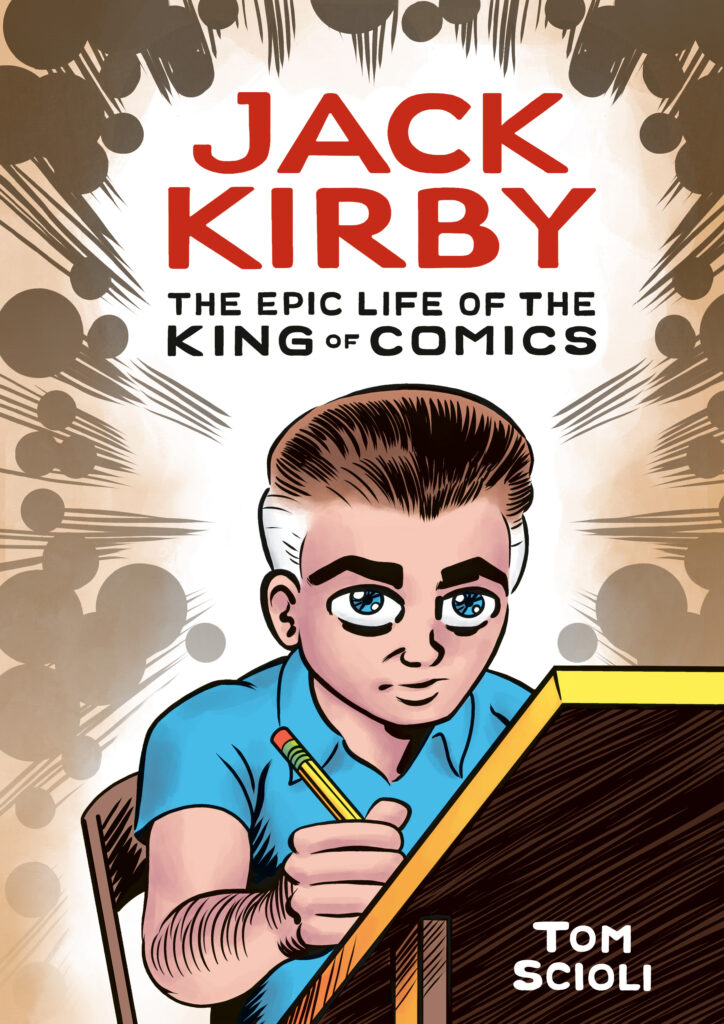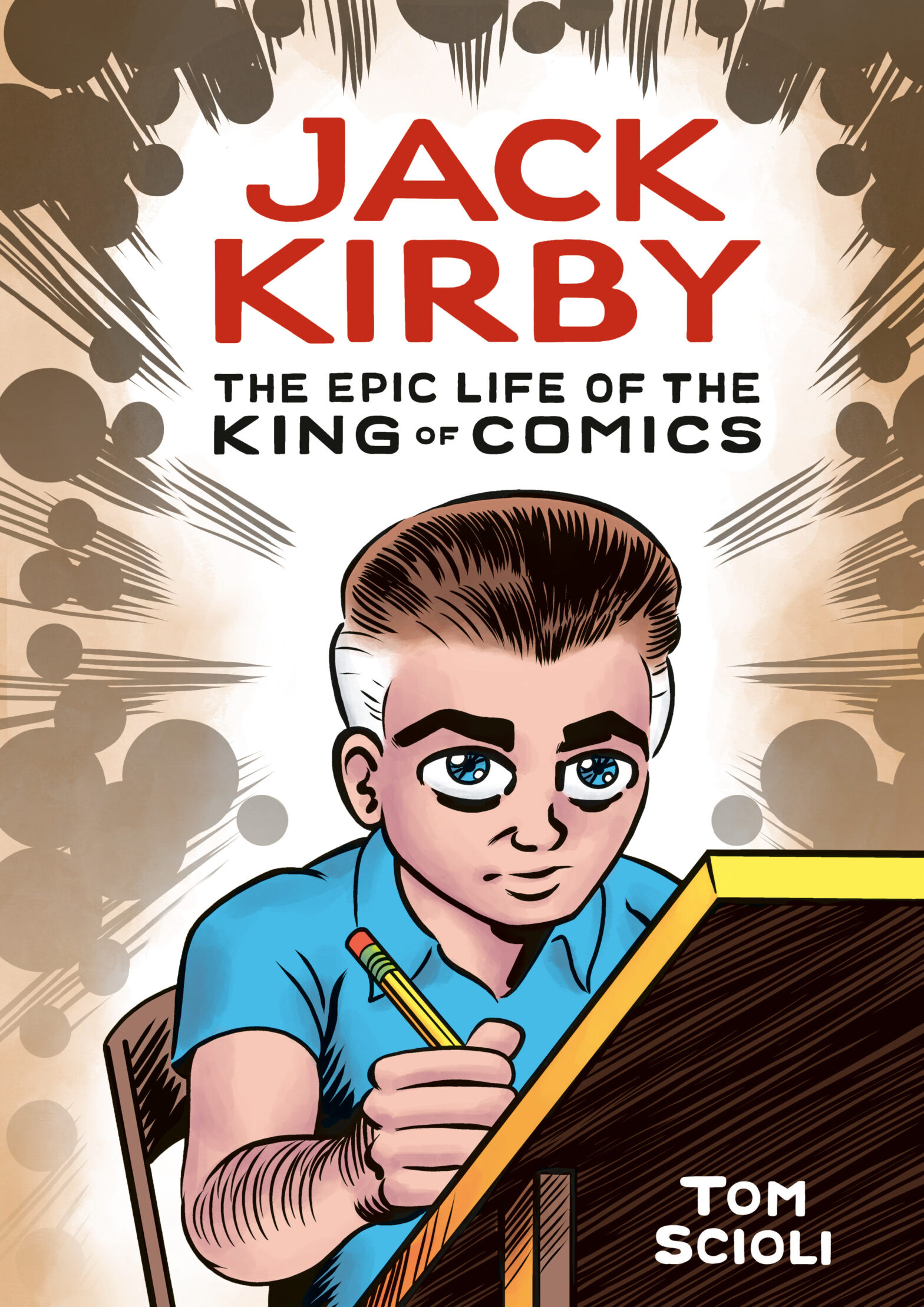Comic Book Review: Jack Kirby by Tom Scioli
Disclaimer: I received a copy of this book through a Goodreads giveaway for the purpose of writing this review. No other compensation was offered or requested.
Jack Kirby (1917-1994) was one of the most prolific and influential American comic book creators of the Twentieth Century. With other noted creators like Joe Simon, Stan Lee and a host of others, he was responsible for such enduring characters as Captain America, the Fantastic Four, the Silver Surfer, Etrigan the Demon, and Darkseid. His influence is still felt today throughout the Marvel and DC universes, as well as independent comics and other media.

This biography is told in graphic novel form, as though Mr. Kirby were narrating it (with a couple of sections told by wife Roz Kirby and colleague Stan Lee.) As much as possible, it uses his actual words from various interviews and speeches. It covers his whole life, plus a little bit of postscript.
Jack’s parents came from Galicia, which is now parts of Poland and Ukraine, though back then it was part of the Austro-Hungarian Empire. They emigrated to America separately, and met in New York through a matchmaker. Jacob Kurtzberg was his birthname, with Jack Kirby initially being a pen name before he found it easiest to just go by it. He showed an aptitude for and interest in drawing from an early age, and a fondness for comic strips (comic books per se not having been invented yet.)
It’s an eventful life, from a poverty-stricken childhood filled with gang violence, to his short-lived animation job, to working in the early days of comic books before superheroes became a thing. Then comes his first big success, working with Simon on Captain America (as well as lesser-known characters.) Unfortunately, they were kicked off the book when the manager of Timely found out they’d also been working for the competition. Still, lots of other work.
This gets interrupted by World War Two. Unlike some other creators who got put into creative jobs for the military, Kirby was drafted into frontline combat, being made a scout when someone finally noticed his art skills. “Go into this Nazi-occupied village and draw pictures of what you see.” A perhaps fortuitous case of frostbite took him out of combat, but the army wouldn’t discharge him until after V-J Day.
Simon and Kirby did well for a while with crime, romance and non-gory comic books, but then came Wertham and after him, the Comics Code, and losing distribution killed their business. Jack worked for National/DC for a while and got a syndicated comic strip, but things turned sour again and Kirby had to axe the strip and burn his bridges with National.
At a low point, Jack Kirby had to turn to Marvel Comics and a man he had hated, Stan Lee. Marvel itself was on the ropes, and Stan had long since forgotten any part he’d had in Kirby and Simon getting fired, so he warmly welcomed Jack back. Kirby started doing a lot of science-fiction related material, even in the books that weren’t strictly supposed to be SF, and when superheroes started coming back, created the Fantastic Four with Stan Lee’s help.
This is where memories really diverge–Kirby claimed that he was responsible for much more of the actual writing and creation of characters than Lee would ever admit. Mr. Lee had to put his name as writer on almost everything that was coming out at Marvel, and it rankled both Jack, and Steve Ditko, another artist with a creative vision that didn’t always match the dialogue Stan put on his stories.
Eventually, the leadership changed at DC Comics, Kirby left Marvel in disgruntlement, and went over to the distinguished competition to create the New Gods saga. But he didn’t actually get the creative control he was promised, and after his work got cancelled time after time, he went back to Marvel for a while, just in time to do a fondly-remembered Bicentennial storyline for Captain America.
By this time, television animation had taken off, and this paid a bit better with less actual work for Kirby, who was beginning to slow down and enjoyed creating character designs and worlds. Plus he finally had health insurance!
Which he needed, as while “King” Kirby was finally getting some of the credit he deserved for creating so much of the comic book landscape, his health was failing.
One of the running themes of this biography is that “comics will break your heart.” Jack Kirby’s talent and overactive work ethic meant that he was almost always in work, but his most commercially successful creations were “work for hire” and didn’t legally belong to him. While he often got a high page rate, that was a one-time payment, and handshake-promised royalties and tie-in money almost never materialized. Executive meddling, personal conflicts and just plain bad luck ended many of his jobs or robbed them of satisfaction.
A telling point is that would-be comics writers often wanted to script for Kirby, saying that they wanted to be “the next Stan Lee”, not catching on that that was the last thing he would be interested in.
But this is history from Jack Kirby’s point of view, and the companion volume about Stan Lee may tell a slightly different story.
Author/artist Tom Scioli is best known for his surreal art and plotlines, which are considerably toned down for this mostly true story. He does a nice job of mimicking Kirby and other artist’s styles as they come up in the book. His one odd touch is drawing Kirby with manga-esque “big eyes” throughout the story, regardless of age, This is done with no other character.
There’s end notes indicating where most of the quotes come from, and an index.
Content note: violence, gore, salty language. Jack is shirtless a few times. Younger readers before late teenagers may find this rough going due to the adult concerns involved.
This is a well-illustrated story of a full life with many interesting incidents. Highly recommended to comic book fans.

